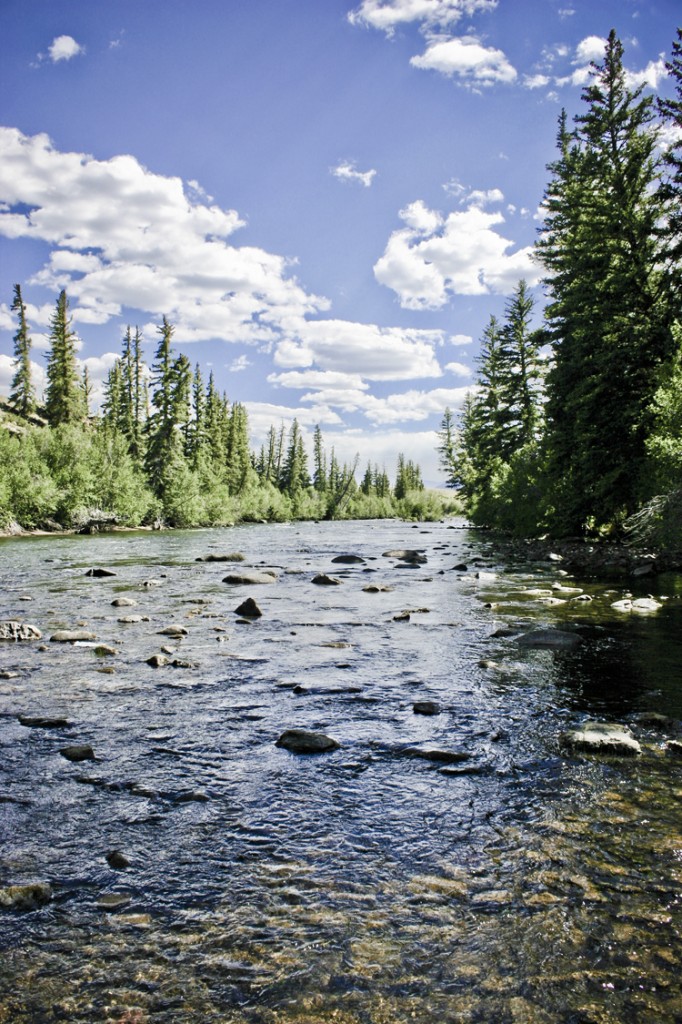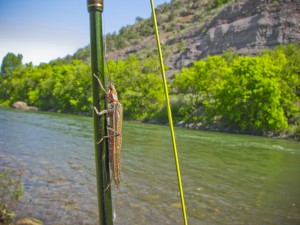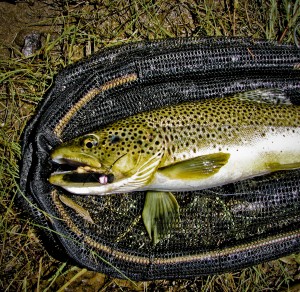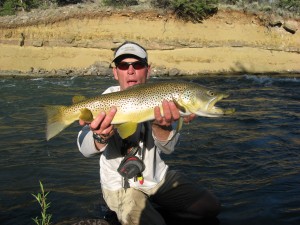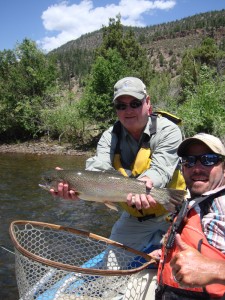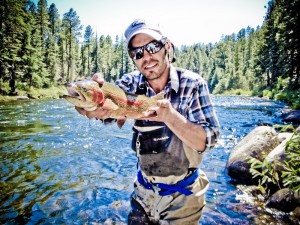Mountain living: peaceful, serine, secluded, safe.
I hear the phrase “the end is nigh” more and more these days. Ok so maybe I don’t hear that exact statement, but something similar is often slipped into daily conversation regarding the state of our world. Those that make this claim go on to explain that when the hour of the world’s undoing ushers forth from the pits of the unknown; they will be heading for the mountains. When earthquakes/hurricanes/tsunamis/ invading North Koreans/IRS/zombies/ economic collapses/IRS zombies begin to lay waste to the face of the earth, those prepared will be ready. From what I gather, this idea involves packing up the mini van with firearms, loading the cooler full of steaks and beer, and making a mad dash to the mountains to wait out Armageddon. I guess the reasoning behind this plan is that the mountains are not only peaceful and serine but also secluded and safe. Well, most would have said the mountains were the safest place bet until June 26th…
Flights were delayed, rerouted, or canceled as America watched images on television of a firestorm issue forth from the safest of mountains into a quiet residential suburb engulfing whole neighborhood blocks in a destructive inferno. Minds were changed about the mountains. Not only the minds of the doomsday preppers (who probably saw it as another sign of the coming apocalypse); but also in the minds of those planning their summer fishing trips. “The mountains are not safe this year, especially the mountains of Colorado” was the collective first reaction. Hotel reservations canceled, plane tickets exchanged, guides now with extra days on their hands.
Well, being a Colorado resident who lives in a mountain town, fly fishes multiple times a week, and is very concerned with the real and present threat of forest fires; let me just lay out the current state of our State, from the early beginnings of summer to today.
A low snow pack and warmer temps brought an early runoff with peak flows hitting southwest CO May 23rd. The early runoff brought with it an interesting and exciting mix of fishing opportunities. The Animas saw it’s first ever salmonfly hatch! Ok so it obviously wasn’t the first salmonfly hatch to EVER grace the waters of the Animas River, but it was the first truly fishable salmonfly hatch that we at Duranglers have seen. This is pretty significant for a few reasons.
We have been fishing here on the Animas since 1982, and we have not seen anything resembling an even mediocre salmonfly hatch in that time. Ever. It was truly surprising to have large fish hammer large dries on a river not know for such occurrences. There are a lot of factors that go into this, but the main factor is the health of the Animas. Stoneflies and salmonflies need clean water in which to thrive. Some say that a solid stonefly hatch is a way to measure the health of a river. With 100 years of mining pollution under our belt up in Silverton, the Animas had seen better days. Does this mean the Animas is recovering as a river? Possibly. We certainly hope so. I still wouldn’t drink out of it though. Another factor to consider is that this was a lower water year with warmer temps. Salmonflies are known not to hatch depending on environmental conditions on even the best salmonfly rivers. Was this a perfect storm of snowpack and weather? I guess we will just have to wait and see next year. A third thought to ponder is that the pteronarcys californica (salmonfly) live 3 years as nymphs before crawling onto shore and emerging into adults. What happened 3 years ago to cause such an emergence now? What is going to happen on the Animas in 3 years? Hopefully stonefly apocalypse.
All over we have seen great hatches happening earlier in the year. Runoff usually marks a time where we catch up on chores around the house waiting for the water to clear up. However, twas was not the case this year. Stoneflies, caddis, and PMDs have been coming off en masse with our slated chore days turning to more productive fishing days. Heck, hopper season started in May on the lower Dolores. Our annual pilgrimage to the Rio Grande was a great dry fly success for those who floated with us…although it was an earlier success than usual. Starting June 6th and running until July 3rd; we chucked salmonflies, stoneflies, caddis, green drakes, grey drakes, PMDs, yellow sallies, etc. Name a summer time dry and we probably fished it this year on the Rio. Yeah we are spoiled. If you have never fished the Rio, I would highly suggest you do some day. It is the closest thing you will find to fishing a Montana-esque river here in Colorado. Also, not to make you jealous or anything, but maybe we hung out with Johnny Depp while he spent time in Creede shooting his new movie, The Lone Ranger…maybe.
Now you are probably asking; “Well that sounds great and all, but what about the fiery wall of inferno death that we have seen on the news? I am fishing elsewhere, Colorado is doomed.” Wrong. So far, this may have been one of the best fish catching years we have seen in a while. Fishing has been fantastic. We had a fire scare for a little bit and it is possible that I packed up the mini van with weapons and provisions in order to flee to Kansas, but that threat has passed. As tragic is it was to see people’s homes go up in giant fireballs, our firefighters have prevailed in preventing fires across the state from causing too much property damage. At one point a few weeks ago, we had a 10,000 acre fire 30 minutes to our west, a 25,000 acre fire 30 minutes to our east, a 300 acre fire 20 minutes south, and a 90 acre fire 5 minutes from the shop.
You may also now be asking; “Well how has these fires affected the fishing?” Well it really hasn’t. The only exception to this would be The Little Sand Fire with its southern boundary running along the banks of the Piedra River by the box canyon. A few of us ventured out about a month ago to assess the fishing, and it was fantastic, although a little smoky. Since then the fire has doubled in size and the full effect of the blaze has yet to be seen, especially with our monsoon season starting. However, as of today, the fire is 60% contained and there have been very little national forest access or campground closures. For more Colorado fire information, go to http://www.inciweb.org/state/6/0/ .
This all brings us to today. What is the fishing like now you ask? Well, really, it is fantastic. Not only did July 4th mark the day of America’s Independence, it also marked the beginning of our monsoon season here in southwest Colorado. The warm air from Arizona and New Mexico moves up and collides with the cooler air of Colorado and…well…I actually don’t really know how it works. Look it up. What I do know is this: the monsoon season brings with it cooler temps and more importantly, rain. Rain: that desperate commodity you cannot acquire yet with any form of currency. Like the climax of a truly great story, the gallant and dashing knight swooped in at the last moment to save the damsel in distress from the evil ogre. The knight being rain, the ogre being forest fires, and our local populace being the damsel in distress. That may be a dumb way to put it, but a change of the winds and Durango could have looked a little more like the western part of Colorado Springs. Anyway, it has rained daily since July 4th, which has helped considerably with the fire situation and the river flow situation, bringing up some of the rivers 50 to 100 cfs.
All of our local water has been fishing fantastic. The cooler temps have brought the fish out to eat throughout the day, not just the mornings and evenings. Your options for wetting a line right now are pretty limitless. The high country has opened completely and is just waiting to be explored. The stillwaters have been fishing great with ants, beetles, damselflies, and callibaetis. Lime, Cascade, Hermosa, Vallecito, and other creeks are doing great with any number of attractor dries. The savior of a low water summer seems to always be brook trout.
Another savior of the low water summer is our local tailwaters. Our private access on the Pine River has been producing some beastly fish with the right presentation. The lower Dolores has been kept at a constant 70 cfs and has been a comfortable constant at that. Like an old friend, I can always rely on the Dolores to produce some nice fish on a splashy hopper pattern throughout the summer or lash out at me in unfettered aggression with her overpopulation of rattlesnakes. Ah memories. The other fantastic constant for all of us here has been The San Juan River. When all else seems hopeless, the legendary San Juan tailwater remains to keep us fishing hard long after the high country has been overrun with 4 wheeling jeepbros. The ant fall just occurred on the San Juan, which sends thousands of size 12 to 14 ants down the pipeline and is a rare opportunity where you can catch large amounts of fish on a large dry. Due to the low water this year, they are also currently keeping the San Juan flows between 800 and 1000 cfs to make up for lower flows elsewhere. This means that if you haven’t been down there in a while, a lot of seemingly fishless areas have now become fishful areas. The San Juan can be frustrating at times I know, so swing by the shop for some advice or take a float with one of our guides. They pretty much live there anyway.
To sum it all up: if you plan on running to the mountains to flee World War 3 anytime soon, bring a fly rod.


